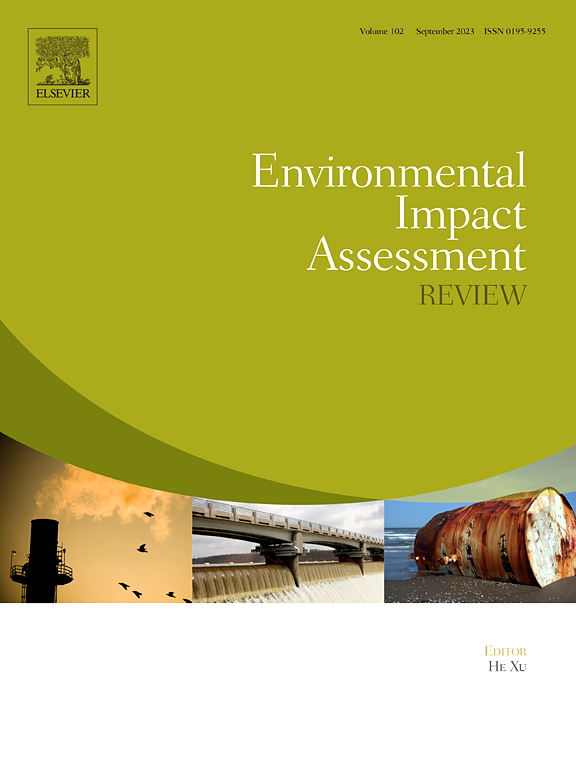Evaluating the environmental impacts of tin ingot production in China: Insight from life cycle assessment
IF 11.2
1区 社会学
Q1 ENVIRONMENTAL STUDIES
引用次数: 0
Abstract
Tin is an indispensable metal for contemporary society, but its extraction processes result in adverse environmental impacts. A comprehensive environmental impact assessment of tin ingot production is crucial to enhance the environmental transparency of downstream products. However, few studies have examined the environmental impacts of tin production, and none have focused on tin ingot production from mining to smelting in China, the global top producer of refined tin. This research endeavors to address this gap by examining the potential environmental impacts of tin ingot (99.95 % tin) production in China for the first time using a life cycle assessment that includes the mining, beneficiation, and smelting stages. An uncertainty analysis was conducted using a Monte Carlo simulation to provide reliable results for stakeholder decision-making. The results showed that the potential environmental impacts on resources, human health, and ecosystem quality from producing one ton of tin ingot were 1.16 × 106 $, 0.10 disability-adjusted life years, and 1.57 × 10−3 Species·year, respectively. The inputs of tin and natural gas in the ground and the emissions of particulates, carbon dioxide, chromium VI, mercury, and iron, were major contributors to the potential environmental burden. These substances primarily originated from the production of tin ore, steel, explosives, freshwater, and natural gas, and direct on-site emissions associated with tin ingot production. Several recommendations were then proposed to promote the sustainable development of tin industry based on these results. These included the promotion of tin recycling, the adjustment of energy structure, the implementation of carbon labeling certification, the use of economic instruments, and the promotion of international cooperation. These findings (e.g., life cycle inventory, impact assessment results, key contributing factors, and recommendations) will provide valuable insights to stakeholders seeking to diminish the environmental strain of the tin and metallurgical industries.
中国锡锭生产的环境影响评价:来自生命周期评价的见解
锡是当代社会不可或缺的金属,但其开采过程对环境造成了不利影响。对锡锭生产进行全面的环境影响评价是提高下游产品环境透明度的关键。然而,很少有研究考察锡生产对环境的影响,也没有研究关注中国这个全球最大的精炼锡生产国从开采到冶炼的锡锭生产。本研究首次采用包括开采、选矿和冶炼阶段在内的生命周期评估方法,考察了中国锡锭(99.95%锡)生产对环境的潜在影响,从而努力解决这一差距。利用蒙特卡罗模拟进行不确定性分析,为利益相关者决策提供可靠的结果。结果表明,生产1吨锡锭对资源、人类健康和生态系统质量的潜在环境影响分别为1.16 × 106 $、0.10伤残调整生命年和1.57 × 10−3物种·年。锡和天然气在地下的输入以及颗粒物、二氧化碳、六价铬、汞和铁的排放是造成潜在环境负担的主要因素。这些物质主要来自锡矿、钢铁、炸药、淡水和天然气的生产,以及与锡锭生产有关的直接现场排放。在此基础上,提出了促进锡工业可持续发展的若干建议。这些措施包括促进锡的回收利用、调整能源结构、实行碳标签认证、使用经济手段和促进国际合作。这些发现(例如,生命周期清单、影响评估结果、关键影响因素和建议)将为寻求减少锡和冶金工业环境压力的利益相关者提供有价值的见解。
本文章由计算机程序翻译,如有差异,请以英文原文为准。
求助全文
约1分钟内获得全文
求助全文
来源期刊

Environmental Impact Assessment Review
ENVIRONMENTAL STUDIES-
CiteScore
12.60
自引率
10.10%
发文量
200
审稿时长
33 days
期刊介绍:
Environmental Impact Assessment Review is an interdisciplinary journal that serves a global audience of practitioners, policymakers, and academics involved in assessing the environmental impact of policies, projects, processes, and products. The journal focuses on innovative theory and practice in environmental impact assessment (EIA). Papers are expected to present innovative ideas, be topical, and coherent. The journal emphasizes concepts, methods, techniques, approaches, and systems related to EIA theory and practice.
 求助内容:
求助内容: 应助结果提醒方式:
应助结果提醒方式:


